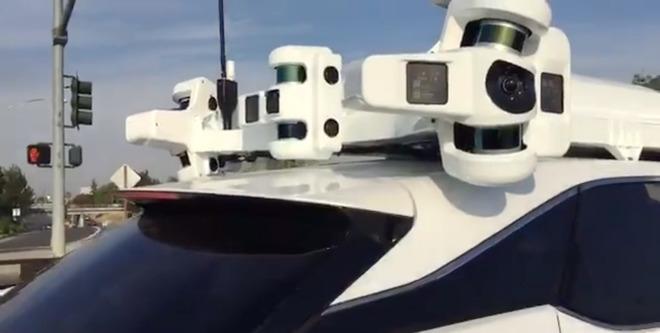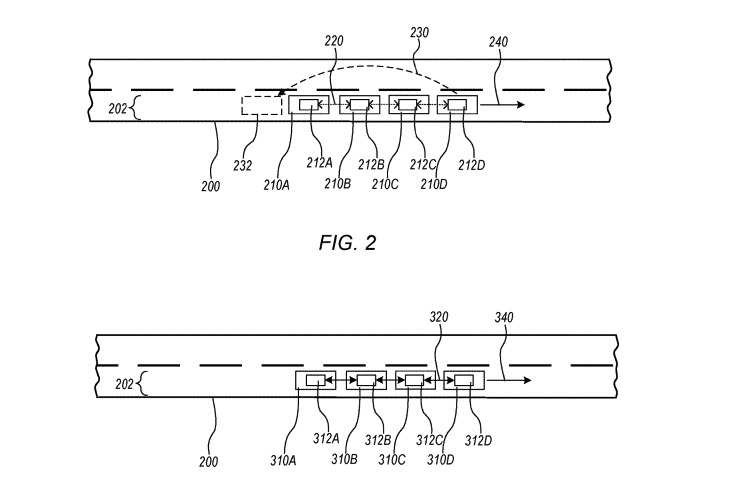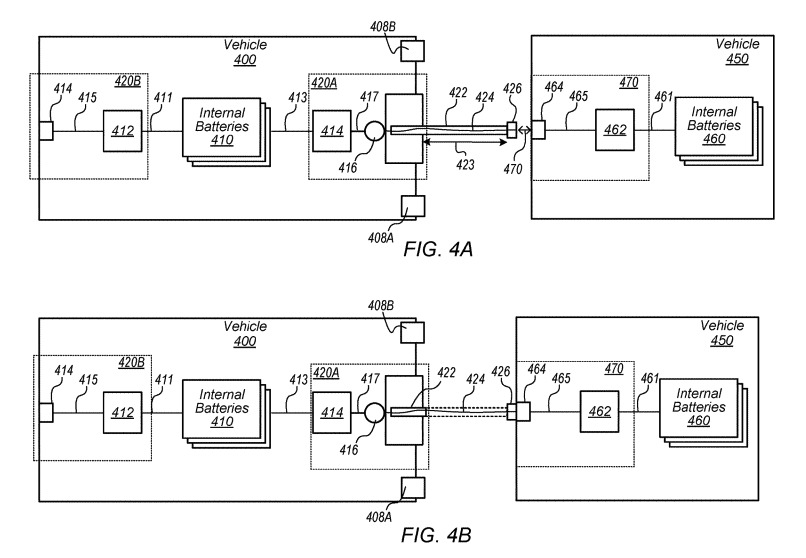Self-driving cars could potentially work together to minimize energy usage on long journeys, with Apple proposing the use of an autonomous peloton of vehicles that could reduce drag for low-performance vehicles, and even the possibility of cars sharing battery power with each other while on the road.
The patent, simply titled "Peloton" and published by the United States Patent and Trademark Office on Tuesday, explains ways that a collection of self-driving vehicles could travel along a road close together in a convoy. On a long journey and at high speeds, a peloton offers potential cost savings to passengers and drivers, both in terms of fuel cost and time.
The system proposed by Apple is similar to those employed by cyclists in a race, where a team could arrange for an initial pair of riders to lead the group, disrupting the airflow and minimizing drag for those behind. Further back riders can conserve energy as they don't have to fight against the wind. At specific times, the riders at the back of the line move to the front, giving the previous leading riders a rest.
For vehicles, the reduction in drag can help vehicles further back in the convoy reduce their fuel usage while maintaining speed, or to increase speed while maintaining the current consumption rate. Apple suggests this could be used to increase the navigational range of a vehicle, potentially to a level where fewer gas station or recharging stops are required, reducing the journey time by minimizing breaks.
In Apple's system, the vehicle navigation system can compare the driving ranges of each vehicle in a peloton and determines a particular order. The system is able to issue instructions to other vehicles, allowing the cars to assemble into an optimal configuration, such as by placing vehicles with larger fuel reserves towards the front so those with lower fuel quantities gain more of the benefits.
While the peloton may help fuel economy simply from driving order, Apple also suggests that electric vehicles driving together could share reserves with each other. A retractable apparatus could be extended between two vehicles, allowing the two to transfer power if required.
In the case of a convoy of electric vehicles, this could allow a car with a drained battery to be recharged by other vehicles in front. Since all vehicles involved are self-driving and capable of communicating with each other, as well as being able to read their locations and the road conditions, it would be feasible for the cars to drive close enough together for a prolonged period of time, one that would allow for an acceptable amount of power to be transferred.
While the power transfer idea is useful for groups driving, it is unclear if it is also intended for use with other road vehicles. Peloton driving offers benefits to all, but presumably it would be up to the driver if they wish to provide others access to their vehicle's power reserves.
Apple files numerous patents every week, but while publication by the USPTO could be a sign of what the company is considering, it isn't a guarantee that it will be made available in a future Apple product or service.
While known for its computing devices, Apple is also exploring automotive technology as part of "Project Titan." The project was originally believed to lead to the creation of an Apple-branded car, but it has since changed focus in favor of self-driving vehicle systems.
Apple is currently operating a fleet of vehicles in California to test and improve its self-driving system. The company is also believed to be working with Volkswagen on the PAIL program, which will ferry employees between Apple offices using autonomous vans.
It is unclear exactly why Apple is working in the field, nor what Apple intends to do with the technology in the future.
A number of patents in the self-driving field have surfaced, including one where the self-driving car will warn other road users of an intention to turn or change lanes via external displays, while another patent application has the vehicle changing the way it drives based on the observed stress levels of its passengers.
More recently, a patent application for "Converter architecture" details how the power train of an electric vehicle could be improved, by using a multiple converters and a secondary battery to change a high-energy source down to a lower voltage. While not directly self-driving related, the patent at least suggests Apple's plans to create its own car are not entirely scrapped.
 Malcolm Owen
Malcolm Owen









-m.jpg)






 Brian Patterson
Brian Patterson
 Charles Martin
Charles Martin



 William Gallagher
William Gallagher
 Christine McKee
Christine McKee
 Marko Zivkovic
Marko Zivkovic









46 Comments
The power sharing is interesting. I doubt it would be popular in today’s #mememe culture.
Might be interesting... Power sharing / peloton driving could be used by car fleets (Hertz, GM, army, field trips to common destinations) and... Trailways and Greyhound private vehicle "trains".
Works great until one car in the line blows a tire.
When I think of self-driving vehicles I think of electric vehicles, a p
To show the problem of a
There’s a pe
Until all vehicles are self-driving the p
One more reason I like Apple as a company. They are doing the basic research that society needs for the future.